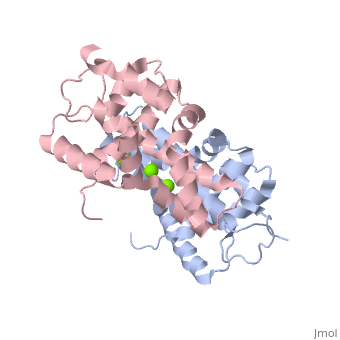Dicer
From Proteopedia
IntroductionDicer, or endoribonuclease Dicer, was discovered/named in 2001 by Emily Bernstein. She was a graduate student in Greg Hannon's lab at the Cold Spring Harbor Laboratory in New York. She was trying to discover the enzyme that was responsible for removing small RNA fragments from double-stranded RNA. The dicer enzyme was found by isolating it from the RISC complex in the RNAi mechanism. It was known that RISC was not responsible for chopping up these small RNA fragments, so this complex was isolated from the system to locate the enzyme that was the source for these RNA fragments.[1] Dicer is a type of Ribonuclease that processes potentially harmful double-stranded RNA (dsRNA) into microRNA and small-interfering RNA (siRNA) to be used in the process of RNA interference. Dicer is commonly utilized by cells in order to prevent the assimilation of viral DNA into the cells’ genome. The viral DNA is butchered into smaller segments that are each about 21 nucleotides long; the cut take places at the 5’ phosphate and the 3’ hydroxyl, and usually includes a 2 nucleotide overhang. There is a single processing center in HS Dicer implying that there are two catalytic sites which help form products with the 2 3' overhang. These newly formed segments attach themselves to single stranded mRNA which ultimately leads to mRNA degradation by the cell and translational suppression. The dicer enzyme in humans contains three domains: the , , and the .[2] There are three classes of RNase III proteins which are divided into categories called Escherichia coli RNase III, , and Dicer which are given the numbers one, two, and three respectively. The Escherichia coli RNase III class has one domain while the Drosha and dicer have two domains each. There is no evidence of the first class of enzymes in mammals.[3] Dicer is a member of the RNase III family, is known as drosophilia CG4792 and it is found in multiple organisms.[2][4] The discovery of Dicer was important for understanding the regulation of gene expression and the epigenetic silencing of genes by miRNA. The human endoribonuclease Dicer is 219 kDa, which is larger than many other organisms' Dicer enzymes. This is due to Humans having different domains present, and in many cases, more domains.[4] StructureHuman Dicer (hDicer) is a . Each chain is a large multidomain enzyme whose C-terminal half includes a PAZ domain, a pair of tandem RNase III domains, and a double-stranded RNA-binding domain.[3] There are four ions that bind to the hDicer RNase IIIb homodimer. There are oxygen ligands bonded to each Magnesium, which create an geometry on each Magnesium. The amino acids present on the oxygen ligands are Glutamic Acid and Aspartic Acid. Human Dicer is made up of helicase and PAZ domains in addition to two RNaseIII domains, A and B, and two double stranded RNA binding domains. The PAZ domain binds the 3' overhang of the dsRNA, while the two dsRNA binding domains bind to the dsRNA to hold the strand in place. At the same time, RNaseIIIa and RNaseIIIb form a dimer, and bind to the dsRNA via the active site. The active site is made up of a combination of the two RNaseIII domains. Both domains contain two Mg2+ ions which each stabilize two glutamine residues and two aspartic acid residues. These combine to form the two halves of the active site which allow the two RNaseIII domains to form the pseudo-dimer around the dsRNA. Between the 3' end of the dsRNA which is bound to the PAZ domain, and the 5' end, which is bound to the PAZ domain loop. This allows for 25 nucleotides to be between the 3' binding site and the RNaseIIIa domain, which is then cleaved to form the RNA fragment. In this mechanism, the Dicer acts as a 25 nucleotide long ruler.[2] ImportanceThe Human Dicer and its mechanism is of the utmost importance because it cleaves these dsRNA's to form small interfering RNA or microRNA, which are then integrated into the RNA-induced silencing complex, or the RISC complex.[2][5] This complex then targets mRNA and prevents translation by disrupting the targeted gene. Without Dicer, gene silencing cannot occur. Therefore, without Dicer, DNA and RNA cannot be regulated. PathologyMutations involving the dicer protein have been linked to the development of diseases in humans. Conditions such as pleuropulmonary blastoma[6], goiter multinodular[7], and rhabdomyosarcoma[8] are related to dicer malfunction. Pleuropulmonary blastoma, goiter multinodular, cystic nephroma, and Sertoli-Leydig cell tumors are due a mutation in the Dicer1 gene given the name Dicer1 Syndrome. Dicer1 Syndrome is an inherited disorder that causes the risk of malignant tumors and benign tumors to increase. This occurs because short Dicer proteins are formed that cannot help in the production of miRNA, which can cause cells to grow into tumors. The risk of tumors is mainly increased in the lungs, kidneys, ovaries, and thyroid. Dicer1 Syndrome is transferred in an autosomal dominant pattern. The top treatment is surgery to remove the tumor.[9] Dicer is known to be a direct cause of macular degeneration. The absence of Dicer in retinal pigment epithelium causes the eye to break down into macular degeneration. It is hypothesized that Dicer has a specific role in maintaining this retinal health.[10] For 3D structures of dicer See Ribonuclease 3D structures References
| ||||||||||||
Proteopedia Page Contributors and Editors (what is this?)
Justin Woodard, Sam Hayes, Michal Harel, Ann Taylor, Wally Novak, Alexander Berchansky

